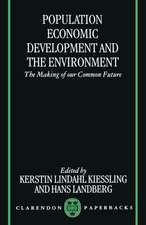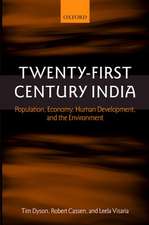Economic and Political Change in Asia and Europe: Social Movement Analyses
Editat de Bernadette Andreosso-O'Callaghan, Frédéric Royallen Limba Engleză Paperback – 20 sep 2014
It is difficult to overstate the relevance of this assessment, which seeks answers to some central questions: Can events in Europe serve as a model for those in East Asia? Are there similarities or differences between the two regions? To what extent do political, economic or social systems stimulate or inhibit collective action? How culturally equivalent are the collective actions of marginalized/ disadvantaged people in the two locations, or are events in Europe symptomatic of specific cultural attributes? Comparing and contrasting the research tools and dominant paradigms in the social and economic sciences in East Asia and Europe, as this volume does, throws out some revealing results.
| Toate formatele și edițiile | Preț | Express |
|---|---|---|
| Paperback (1) | 945.92 lei 6-8 săpt. | |
| SPRINGER NETHERLANDS – 20 sep 2014 | 945.92 lei 6-8 săpt. | |
| Hardback (1) | 951.91 lei 6-8 săpt. | |
| SPRINGER NETHERLANDS – 10 aug 2012 | 951.91 lei 6-8 săpt. |
Preț: 945.92 lei
Preț vechi: 1153.57 lei
-18% Nou
Puncte Express: 1419
Preț estimativ în valută:
181.01€ • 193.55$ • 150.92£
181.01€ • 193.55$ • 150.92£
Carte tipărită la comandă
Livrare economică 18 aprilie-02 mai
Preluare comenzi: 021 569.72.76
Specificații
ISBN-13: 9789400792111
ISBN-10: 9400792115
Pagini: 324
Ilustrații: XVIII, 306 p.
Dimensiuni: 155 x 235 x 17 mm
Greutate: 0.46 kg
Ediția:2013
Editura: SPRINGER NETHERLANDS
Colecția Springer
Locul publicării:Dordrecht, Netherlands
ISBN-10: 9400792115
Pagini: 324
Ilustrații: XVIII, 306 p.
Dimensiuni: 155 x 235 x 17 mm
Greutate: 0.46 kg
Ediția:2013
Editura: SPRINGER NETHERLANDS
Colecția Springer
Locul publicării:Dordrecht, Netherlands
Public țintă
ResearchCuprins
Acknowledgements.- List of Abbreviations .- List of Tables, Figures, and Appendices.- 1: Collective Action and Relatively Powerless People in Europe and Asia: Bernadette Andreosso-O’Callaghan and Frédéric Royall.- Part I: Economic, Political and Social Globalization in Asia and Europe.- 2: Economic Change and Social a Dynamics: Converging and Diverging Trends Across Different Economies: Bernadette Andreosso-O’Callaghan.- 3: European Integration, Social Cohesion and Political Contentiousness: Christian Lahusen.- 4: Images and Frameworks of Collective Action in China: Carsten Storm.- 5: European Governance and Democracy: Didier Chabanet.- 6: Agricultural Markets and Food Riots: The European Union and Asia Compared: M. Bruna Zolin.- Part II: Social Movements in a Transnational Perspective.- 7: Marginalization and Transnationalizing Social Movements: How One Relates to the Other: Pascale Dufour .- 8: Transnational Collective Action and the European Network of the Unemployed: Frédéric Royall.- Part III: National Examples.- 9: The British and French Hunger Marches of the 1930s:An Exclusive Mode of Protest, a Cultural Transfer and a Fulcrum Of Success: Matt Perry.- 10: Comparing Mobilizations Against Three Social Reforms in the 2000s in Belgium: Jean Faniel.- 11: Employment Status and Political Participation: Does Exclusion Influence the Protest Behavior of the Young Unemployed?: Marco Giugni and Jasmine Lorenzini .- 12: The Practical Uses of Administrative and Cultural Categories Across the Field of Pro-Gypsy Activities in France Today: Activist Constructions and Adaptations to Political Categorizations: Anne-Cécile Renouard .- 13: Challenges of Social Engagement: NGO Work in the People’s Republic of China: Birgit Häse.- 14: The Suicide Problem in Contemporary Japanese Society: Its Economic and Social Backdrop and Religious Reactions: Michiaki Okuyama.- 15:Constructing and ControllingPeople’s Power from the Grassroots.- Philippine Social Movement Activism in a Historical Perspective: Dominique Caouette .- Part IV: Commentary.- 16: What Do Social Scientists Do When They Do Comparative Work?: Lilian Mathieu.- Bibliography.- Contributors.- IndexPart II: Social Movements in a Transnational Perspective.- 7: Marginalization and Transnationalizing Social Movements: How One Relates to the Other: Pascale Dufour .- 8: Transnational Collective Action and the European Network of the Unemployed: Frédéric Royall.- Part III: National Examples.- 9: The British and French Hunger Marches of the 1930s:An Exclusive Mode of Protest, a Cultural Transfer and a Fulcrum Of Success: Matt Perry.- 10: Comparing Mobilizations Against Three Social Reforms in the 2000s in Belgium: Jean Faniel.- 11: Employment Status and Political Participation: Does Exclusion Influence the Protest Behavior of the Young Unemployed?: Marco Giugni and Jasmine Lorenzini .- 12: The Practical Uses of Administrative and Cultural Categories Across the Field of Pro-Gypsy Activities in France Today: Activist Constructions and Adaptations to Political Categorizations: Anne-Cécile Renouard .- 13: Challenges of Social Engagement: NGO Work in the People’s Republic of China: Birgit Häse.- 14: The Suicide Problem in Contemporary Japanese Society: Its Economic and Social Backdrop and Religious Reactions: Michiaki Okuyama.- 15:Constructing and Controlling People’s Power from the Grassroots.- Philippine Social Movement Activism in a Historical Perspective: Dominique Caouette .- Part IV: Commentary.- 16: What Do Social Scientists Do When They Do Comparative Work?: Lilian Mathieu.- Bibliography.- Contributors.- Index.
Textul de pe ultima copertă
Since the 1973 publication of Alain Peyrefitte’s prophetic When China Awakens, developments in East Asia have outstripped even the wildest predictions. China has undergone the fastest industrialization and urbanization process in history, yet tensions there are rising as some realize how far they have been left behind. This volume explores the applicability of European economic and social models to our analysis of East Asia’s and, in particular, China’s situation. Though millions of Chinese and other Asian people have been lifted out of poverty, inequality is rising nonetheless, and contemporary Europe and Asia are both witnessing collective action against rampant economic neoliberalism in the former and the exclusion of minorities in the latter.
It is difficult to overstate the relevance of this assessment, which seeks answers to some central questions: Can events in Europe serve as a model for those in East Asia? Are there similarities or differences between the two regions? To what extent do political, economic or social systems stimulate or inhibit collective action? How culturally equivalent are the collective actions of marginalized/ disadvantaged people in the two locations, or are events in Europe symptomatic of specific cultural attributes? Comparing and contrasting the research tools and dominant paradigms in the social and economic sciences in East Asia and Europe, as this volume does, throws out some revealing results.
It is difficult to overstate the relevance of this assessment, which seeks answers to some central questions: Can events in Europe serve as a model for those in East Asia? Are there similarities or differences between the two regions? To what extent do political, economic or social systems stimulate or inhibit collective action? How culturally equivalent are the collective actions of marginalized/ disadvantaged people in the two locations, or are events in Europe symptomatic of specific cultural attributes? Comparing and contrasting the research tools and dominant paradigms in the social and economic sciences in East Asia and Europe, as this volume does, throws out some revealing results.
Caracteristici
Provides comparative analyses of social movements in Europe and Asia Development of different methodologies and analyses to explain the Asia (as opposed to the European) cases Integrates elements from political science, cultural studies as well as economics
















